Unit 17: Understanding and Leading Change - Analysis and Strategies
VerifiedAdded on 2023/01/16
|17
|5405
|73
Report
AI Summary
This report provides a comprehensive analysis of understanding and leading change within organizations, focusing on Sainsbury and Marks and Spencer as case studies. It explores the drivers of change, the impact of these changes on organizational strategies and operations, and different types of organizational change. The report also examines the influence of change on leadership, individual and team behaviors, and proposes measures to minimize negative impacts. Furthermore, it critically evaluates organizational responses to change by applying theories such as the Continuous Improvement Model and the Burke Litwen Model. The analysis includes a force field analysis to identify driving and resisting forces, and discusses barriers to change and various leadership approaches to manage change effectively. The report concludes with recommendations for successful change implementation.
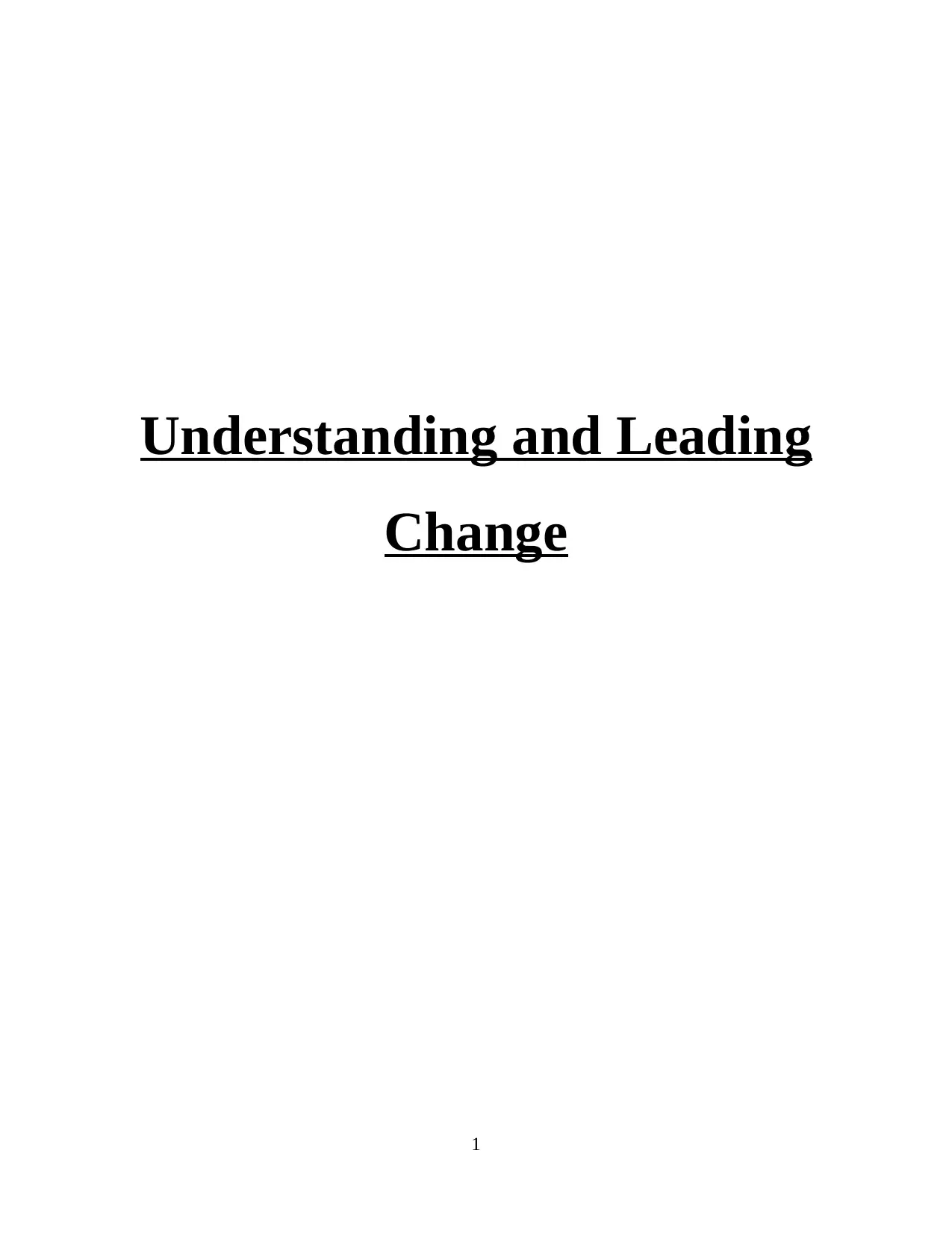
Understanding and Leading
Change
1
Change
1
Paraphrase This Document
Need a fresh take? Get an instant paraphrase of this document with our AI Paraphraser
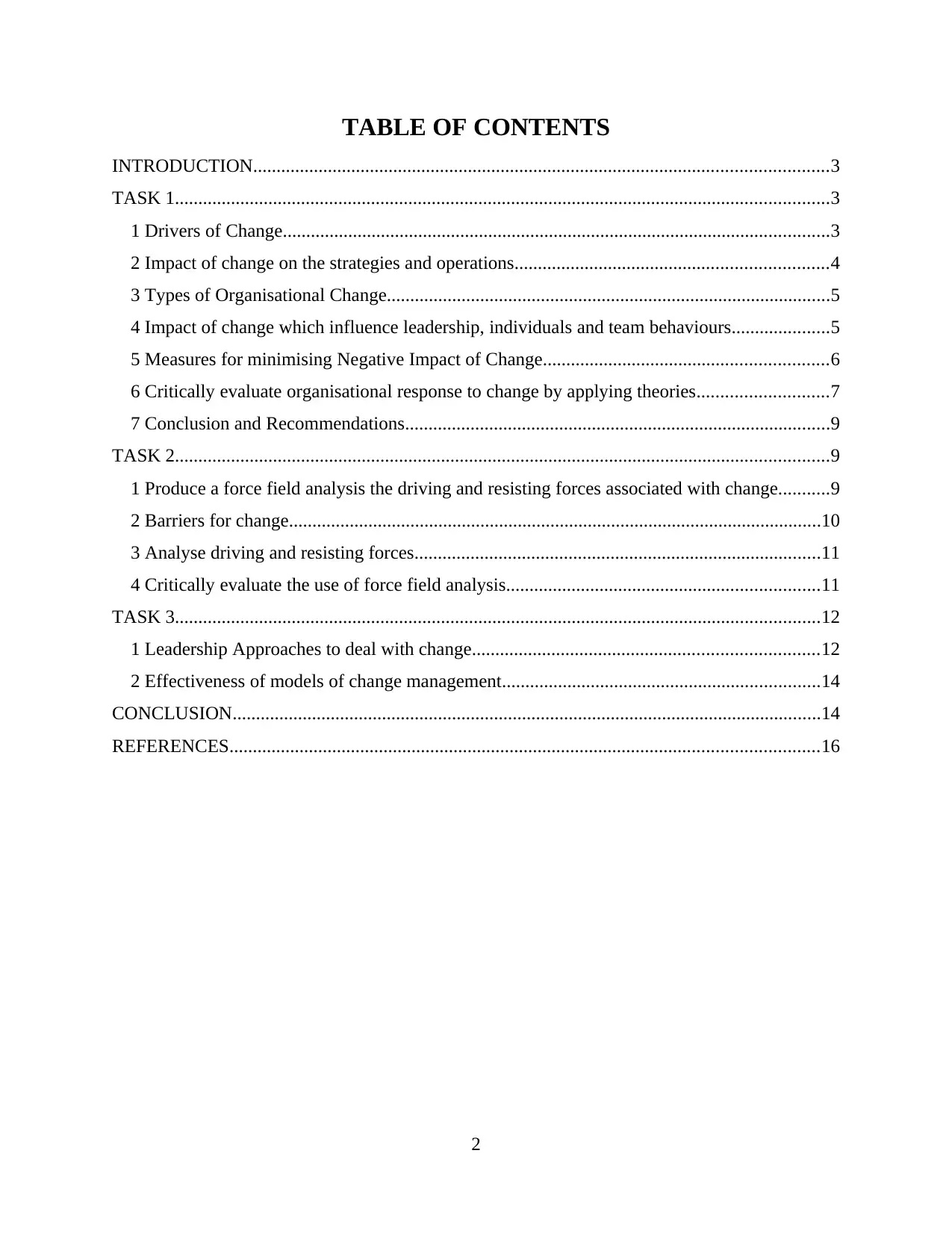
TABLE OF CONTENTS
INTRODUCTION...........................................................................................................................3
TASK 1............................................................................................................................................3
1 Drivers of Change.....................................................................................................................3
2 Impact of change on the strategies and operations...................................................................4
3 Types of Organisational Change...............................................................................................5
4 Impact of change which influence leadership, individuals and team behaviours.....................5
5 Measures for minimising Negative Impact of Change.............................................................6
6 Critically evaluate organisational response to change by applying theories............................7
7 Conclusion and Recommendations...........................................................................................9
TASK 2............................................................................................................................................9
1 Produce a force field analysis the driving and resisting forces associated with change...........9
2 Barriers for change..................................................................................................................10
3 Analyse driving and resisting forces.......................................................................................11
4 Critically evaluate the use of force field analysis...................................................................11
TASK 3..........................................................................................................................................12
1 Leadership Approaches to deal with change..........................................................................12
2 Effectiveness of models of change management....................................................................14
CONCLUSION..............................................................................................................................14
REFERENCES..............................................................................................................................16
2
INTRODUCTION...........................................................................................................................3
TASK 1............................................................................................................................................3
1 Drivers of Change.....................................................................................................................3
2 Impact of change on the strategies and operations...................................................................4
3 Types of Organisational Change...............................................................................................5
4 Impact of change which influence leadership, individuals and team behaviours.....................5
5 Measures for minimising Negative Impact of Change.............................................................6
6 Critically evaluate organisational response to change by applying theories............................7
7 Conclusion and Recommendations...........................................................................................9
TASK 2............................................................................................................................................9
1 Produce a force field analysis the driving and resisting forces associated with change...........9
2 Barriers for change..................................................................................................................10
3 Analyse driving and resisting forces.......................................................................................11
4 Critically evaluate the use of force field analysis...................................................................11
TASK 3..........................................................................................................................................12
1 Leadership Approaches to deal with change..........................................................................12
2 Effectiveness of models of change management....................................................................14
CONCLUSION..............................................................................................................................14
REFERENCES..............................................................................................................................16
2
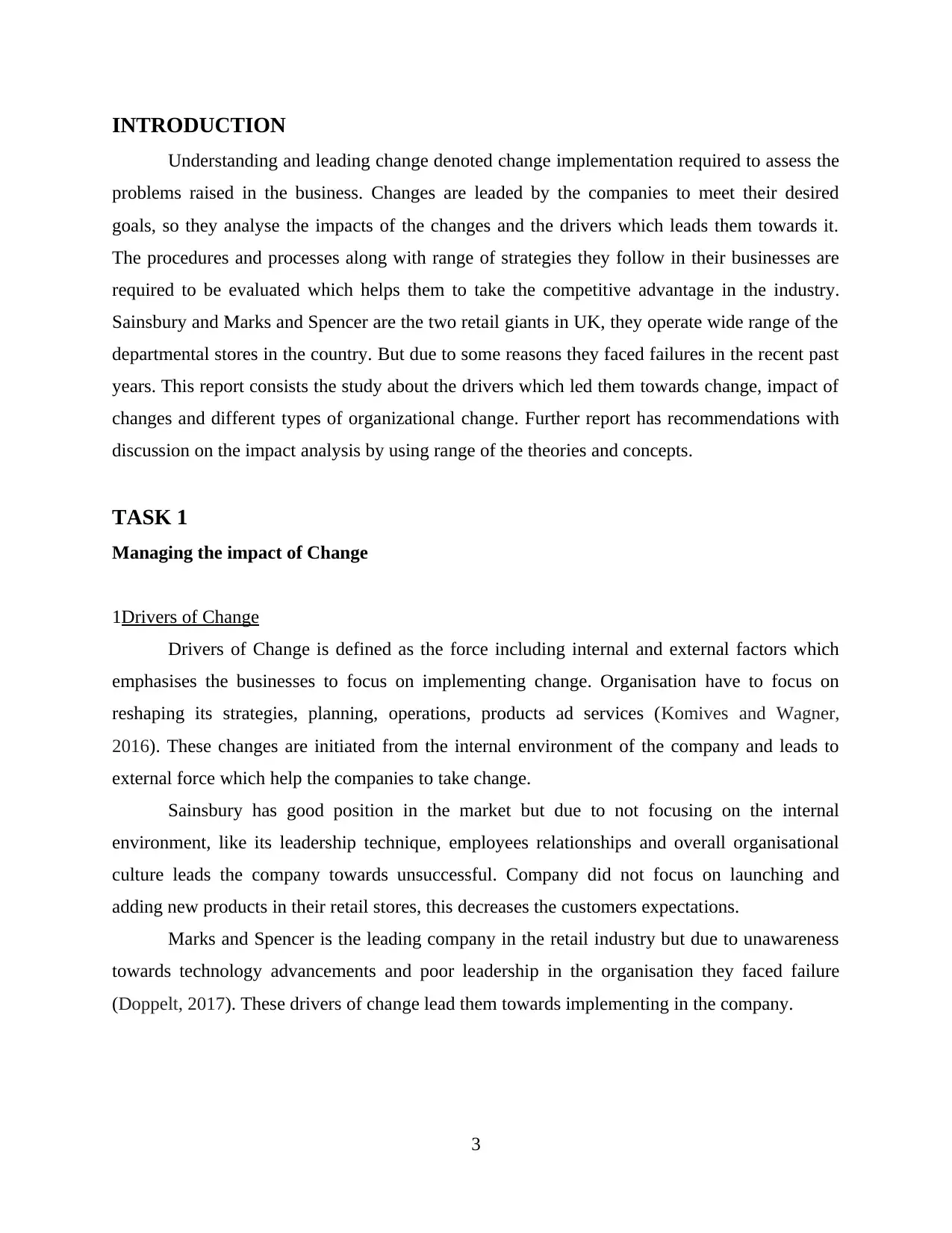
INTRODUCTION
Understanding and leading change denoted change implementation required to assess the
problems raised in the business. Changes are leaded by the companies to meet their desired
goals, so they analyse the impacts of the changes and the drivers which leads them towards it.
The procedures and processes along with range of strategies they follow in their businesses are
required to be evaluated which helps them to take the competitive advantage in the industry.
Sainsbury and Marks and Spencer are the two retail giants in UK, they operate wide range of the
departmental stores in the country. But due to some reasons they faced failures in the recent past
years. This report consists the study about the drivers which led them towards change, impact of
changes and different types of organizational change. Further report has recommendations with
discussion on the impact analysis by using range of the theories and concepts.
TASK 1
Managing the impact of Change
1Drivers of Change
Drivers of Change is defined as the force including internal and external factors which
emphasises the businesses to focus on implementing change. Organisation have to focus on
reshaping its strategies, planning, operations, products ad services (Komives and Wagner,
2016). These changes are initiated from the internal environment of the company and leads to
external force which help the companies to take change.
Sainsbury has good position in the market but due to not focusing on the internal
environment, like its leadership technique, employees relationships and overall organisational
culture leads the company towards unsuccessful. Company did not focus on launching and
adding new products in their retail stores, this decreases the customers expectations.
Marks and Spencer is the leading company in the retail industry but due to unawareness
towards technology advancements and poor leadership in the organisation they faced failure
(Doppelt, 2017). These drivers of change lead them towards implementing in the company.
3
Understanding and leading change denoted change implementation required to assess the
problems raised in the business. Changes are leaded by the companies to meet their desired
goals, so they analyse the impacts of the changes and the drivers which leads them towards it.
The procedures and processes along with range of strategies they follow in their businesses are
required to be evaluated which helps them to take the competitive advantage in the industry.
Sainsbury and Marks and Spencer are the two retail giants in UK, they operate wide range of the
departmental stores in the country. But due to some reasons they faced failures in the recent past
years. This report consists the study about the drivers which led them towards change, impact of
changes and different types of organizational change. Further report has recommendations with
discussion on the impact analysis by using range of the theories and concepts.
TASK 1
Managing the impact of Change
1Drivers of Change
Drivers of Change is defined as the force including internal and external factors which
emphasises the businesses to focus on implementing change. Organisation have to focus on
reshaping its strategies, planning, operations, products ad services (Komives and Wagner,
2016). These changes are initiated from the internal environment of the company and leads to
external force which help the companies to take change.
Sainsbury has good position in the market but due to not focusing on the internal
environment, like its leadership technique, employees relationships and overall organisational
culture leads the company towards unsuccessful. Company did not focus on launching and
adding new products in their retail stores, this decreases the customers expectations.
Marks and Spencer is the leading company in the retail industry but due to unawareness
towards technology advancements and poor leadership in the organisation they faced failure
(Doppelt, 2017). These drivers of change lead them towards implementing in the company.
3
⊘ This is a preview!⊘
Do you want full access?
Subscribe today to unlock all pages.

Trusted by 1+ million students worldwide
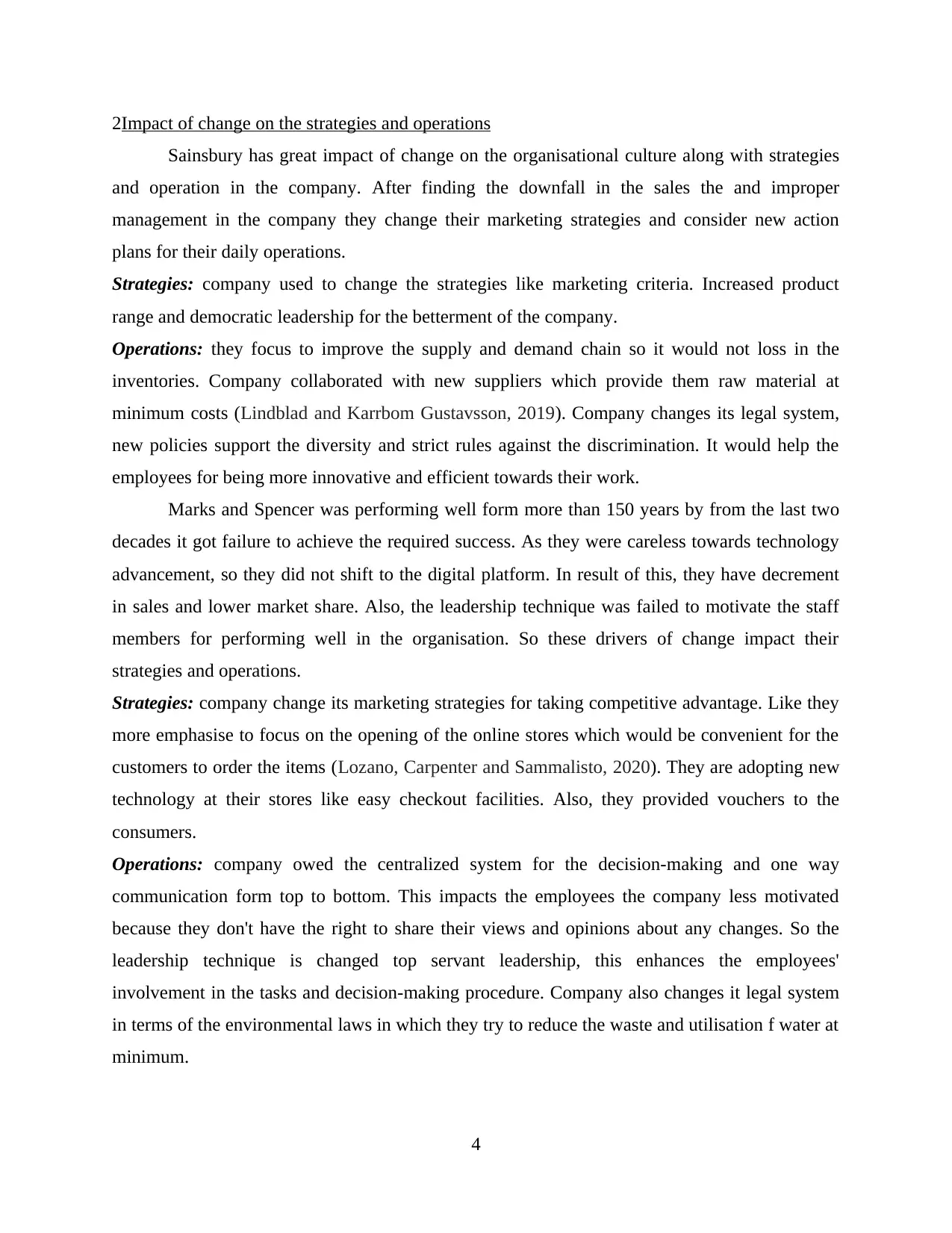
2Impact of change on the strategies and operations
Sainsbury has great impact of change on the organisational culture along with strategies
and operation in the company. After finding the downfall in the sales the and improper
management in the company they change their marketing strategies and consider new action
plans for their daily operations.
Strategies: company used to change the strategies like marketing criteria. Increased product
range and democratic leadership for the betterment of the company.
Operations: they focus to improve the supply and demand chain so it would not loss in the
inventories. Company collaborated with new suppliers which provide them raw material at
minimum costs (Lindblad and Karrbom Gustavsson, 2019). Company changes its legal system,
new policies support the diversity and strict rules against the discrimination. It would help the
employees for being more innovative and efficient towards their work.
Marks and Spencer was performing well form more than 150 years by from the last two
decades it got failure to achieve the required success. As they were careless towards technology
advancement, so they did not shift to the digital platform. In result of this, they have decrement
in sales and lower market share. Also, the leadership technique was failed to motivate the staff
members for performing well in the organisation. So these drivers of change impact their
strategies and operations.
Strategies: company change its marketing strategies for taking competitive advantage. Like they
more emphasise to focus on the opening of the online stores which would be convenient for the
customers to order the items (Lozano, Carpenter and Sammalisto, 2020). They are adopting new
technology at their stores like easy checkout facilities. Also, they provided vouchers to the
consumers.
Operations: company owed the centralized system for the decision-making and one way
communication form top to bottom. This impacts the employees the company less motivated
because they don't have the right to share their views and opinions about any changes. So the
leadership technique is changed top servant leadership, this enhances the employees'
involvement in the tasks and decision-making procedure. Company also changes it legal system
in terms of the environmental laws in which they try to reduce the waste and utilisation f water at
minimum.
4
Sainsbury has great impact of change on the organisational culture along with strategies
and operation in the company. After finding the downfall in the sales the and improper
management in the company they change their marketing strategies and consider new action
plans for their daily operations.
Strategies: company used to change the strategies like marketing criteria. Increased product
range and democratic leadership for the betterment of the company.
Operations: they focus to improve the supply and demand chain so it would not loss in the
inventories. Company collaborated with new suppliers which provide them raw material at
minimum costs (Lindblad and Karrbom Gustavsson, 2019). Company changes its legal system,
new policies support the diversity and strict rules against the discrimination. It would help the
employees for being more innovative and efficient towards their work.
Marks and Spencer was performing well form more than 150 years by from the last two
decades it got failure to achieve the required success. As they were careless towards technology
advancement, so they did not shift to the digital platform. In result of this, they have decrement
in sales and lower market share. Also, the leadership technique was failed to motivate the staff
members for performing well in the organisation. So these drivers of change impact their
strategies and operations.
Strategies: company change its marketing strategies for taking competitive advantage. Like they
more emphasise to focus on the opening of the online stores which would be convenient for the
customers to order the items (Lozano, Carpenter and Sammalisto, 2020). They are adopting new
technology at their stores like easy checkout facilities. Also, they provided vouchers to the
consumers.
Operations: company owed the centralized system for the decision-making and one way
communication form top to bottom. This impacts the employees the company less motivated
because they don't have the right to share their views and opinions about any changes. So the
leadership technique is changed top servant leadership, this enhances the employees'
involvement in the tasks and decision-making procedure. Company also changes it legal system
in terms of the environmental laws in which they try to reduce the waste and utilisation f water at
minimum.
4
Paraphrase This Document
Need a fresh take? Get an instant paraphrase of this document with our AI Paraphraser
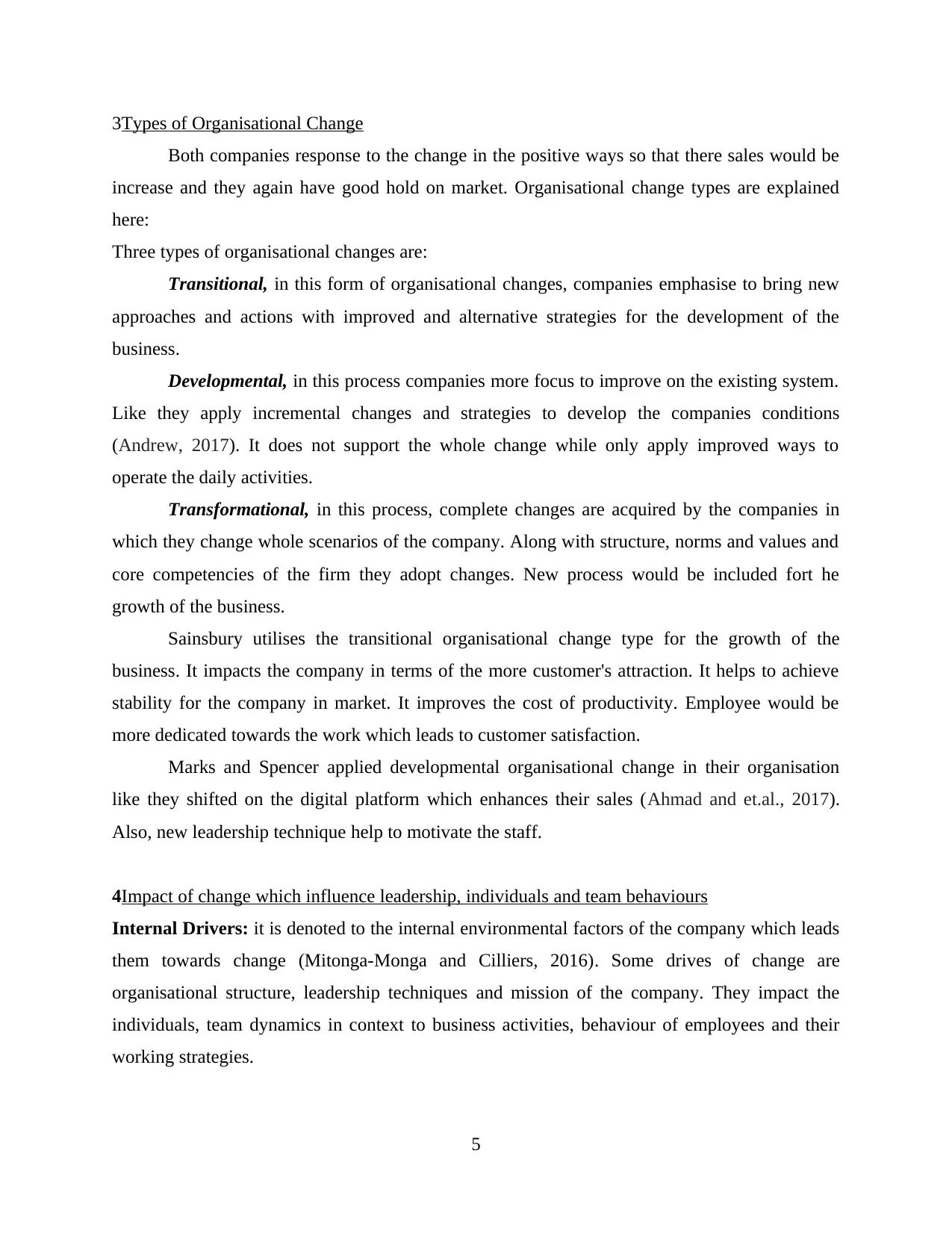
3Types of Organisational Change
Both companies response to the change in the positive ways so that there sales would be
increase and they again have good hold on market. Organisational change types are explained
here:
Three types of organisational changes are:
Transitional, in this form of organisational changes, companies emphasise to bring new
approaches and actions with improved and alternative strategies for the development of the
business.
Developmental, in this process companies more focus to improve on the existing system.
Like they apply incremental changes and strategies to develop the companies conditions
(Andrew, 2017). It does not support the whole change while only apply improved ways to
operate the daily activities.
Transformational, in this process, complete changes are acquired by the companies in
which they change whole scenarios of the company. Along with structure, norms and values and
core competencies of the firm they adopt changes. New process would be included fort he
growth of the business.
Sainsbury utilises the transitional organisational change type for the growth of the
business. It impacts the company in terms of the more customer's attraction. It helps to achieve
stability for the company in market. It improves the cost of productivity. Employee would be
more dedicated towards the work which leads to customer satisfaction.
Marks and Spencer applied developmental organisational change in their organisation
like they shifted on the digital platform which enhances their sales (Ahmad and et.al., 2017).
Also, new leadership technique help to motivate the staff.
4Impact of change which influence leadership, individuals and team behaviours
Internal Drivers: it is denoted to the internal environmental factors of the company which leads
them towards change (Mitonga-Monga and Cilliers, 2016). Some drives of change are
organisational structure, leadership techniques and mission of the company. They impact the
individuals, team dynamics in context to business activities, behaviour of employees and their
working strategies.
5
Both companies response to the change in the positive ways so that there sales would be
increase and they again have good hold on market. Organisational change types are explained
here:
Three types of organisational changes are:
Transitional, in this form of organisational changes, companies emphasise to bring new
approaches and actions with improved and alternative strategies for the development of the
business.
Developmental, in this process companies more focus to improve on the existing system.
Like they apply incremental changes and strategies to develop the companies conditions
(Andrew, 2017). It does not support the whole change while only apply improved ways to
operate the daily activities.
Transformational, in this process, complete changes are acquired by the companies in
which they change whole scenarios of the company. Along with structure, norms and values and
core competencies of the firm they adopt changes. New process would be included fort he
growth of the business.
Sainsbury utilises the transitional organisational change type for the growth of the
business. It impacts the company in terms of the more customer's attraction. It helps to achieve
stability for the company in market. It improves the cost of productivity. Employee would be
more dedicated towards the work which leads to customer satisfaction.
Marks and Spencer applied developmental organisational change in their organisation
like they shifted on the digital platform which enhances their sales (Ahmad and et.al., 2017).
Also, new leadership technique help to motivate the staff.
4Impact of change which influence leadership, individuals and team behaviours
Internal Drivers: it is denoted to the internal environmental factors of the company which leads
them towards change (Mitonga-Monga and Cilliers, 2016). Some drives of change are
organisational structure, leadership techniques and mission of the company. They impact the
individuals, team dynamics in context to business activities, behaviour of employees and their
working strategies.
5
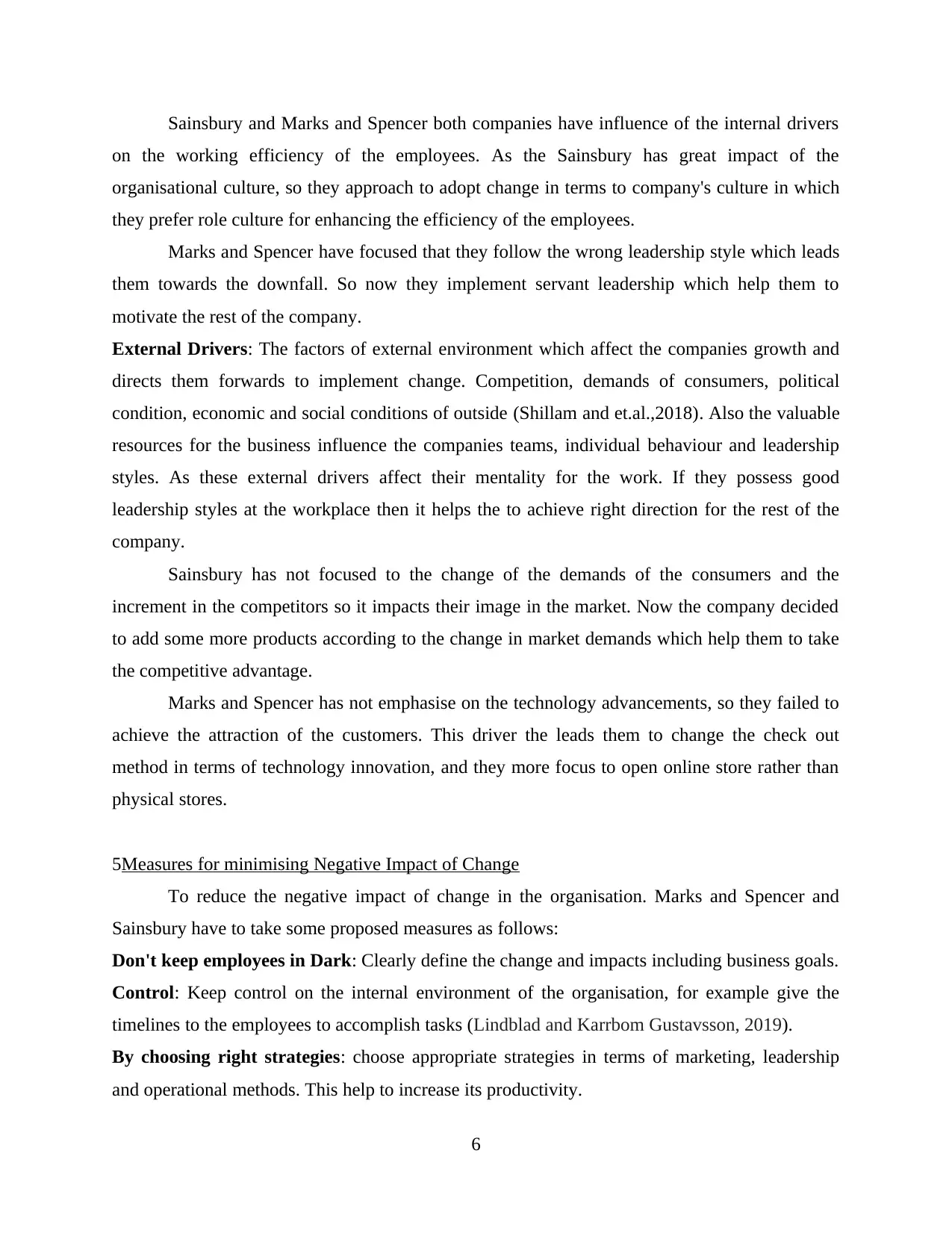
Sainsbury and Marks and Spencer both companies have influence of the internal drivers
on the working efficiency of the employees. As the Sainsbury has great impact of the
organisational culture, so they approach to adopt change in terms to company's culture in which
they prefer role culture for enhancing the efficiency of the employees.
Marks and Spencer have focused that they follow the wrong leadership style which leads
them towards the downfall. So now they implement servant leadership which help them to
motivate the rest of the company.
External Drivers: The factors of external environment which affect the companies growth and
directs them forwards to implement change. Competition, demands of consumers, political
condition, economic and social conditions of outside (Shillam and et.al.,2018). Also the valuable
resources for the business influence the companies teams, individual behaviour and leadership
styles. As these external drivers affect their mentality for the work. If they possess good
leadership styles at the workplace then it helps the to achieve right direction for the rest of the
company.
Sainsbury has not focused to the change of the demands of the consumers and the
increment in the competitors so it impacts their image in the market. Now the company decided
to add some more products according to the change in market demands which help them to take
the competitive advantage.
Marks and Spencer has not emphasise on the technology advancements, so they failed to
achieve the attraction of the customers. This driver the leads them to change the check out
method in terms of technology innovation, and they more focus to open online store rather than
physical stores.
5Measures for minimising Negative Impact of Change
To reduce the negative impact of change in the organisation. Marks and Spencer and
Sainsbury have to take some proposed measures as follows:
Don't keep employees in Dark: Clearly define the change and impacts including business goals.
Control: Keep control on the internal environment of the organisation, for example give the
timelines to the employees to accomplish tasks (Lindblad and Karrbom Gustavsson, 2019).
By choosing right strategies: choose appropriate strategies in terms of marketing, leadership
and operational methods. This help to increase its productivity.
6
on the working efficiency of the employees. As the Sainsbury has great impact of the
organisational culture, so they approach to adopt change in terms to company's culture in which
they prefer role culture for enhancing the efficiency of the employees.
Marks and Spencer have focused that they follow the wrong leadership style which leads
them towards the downfall. So now they implement servant leadership which help them to
motivate the rest of the company.
External Drivers: The factors of external environment which affect the companies growth and
directs them forwards to implement change. Competition, demands of consumers, political
condition, economic and social conditions of outside (Shillam and et.al.,2018). Also the valuable
resources for the business influence the companies teams, individual behaviour and leadership
styles. As these external drivers affect their mentality for the work. If they possess good
leadership styles at the workplace then it helps the to achieve right direction for the rest of the
company.
Sainsbury has not focused to the change of the demands of the consumers and the
increment in the competitors so it impacts their image in the market. Now the company decided
to add some more products according to the change in market demands which help them to take
the competitive advantage.
Marks and Spencer has not emphasise on the technology advancements, so they failed to
achieve the attraction of the customers. This driver the leads them to change the check out
method in terms of technology innovation, and they more focus to open online store rather than
physical stores.
5Measures for minimising Negative Impact of Change
To reduce the negative impact of change in the organisation. Marks and Spencer and
Sainsbury have to take some proposed measures as follows:
Don't keep employees in Dark: Clearly define the change and impacts including business goals.
Control: Keep control on the internal environment of the organisation, for example give the
timelines to the employees to accomplish tasks (Lindblad and Karrbom Gustavsson, 2019).
By choosing right strategies: choose appropriate strategies in terms of marketing, leadership
and operational methods. This help to increase its productivity.
6
⊘ This is a preview!⊘
Do you want full access?
Subscribe today to unlock all pages.

Trusted by 1+ million students worldwide
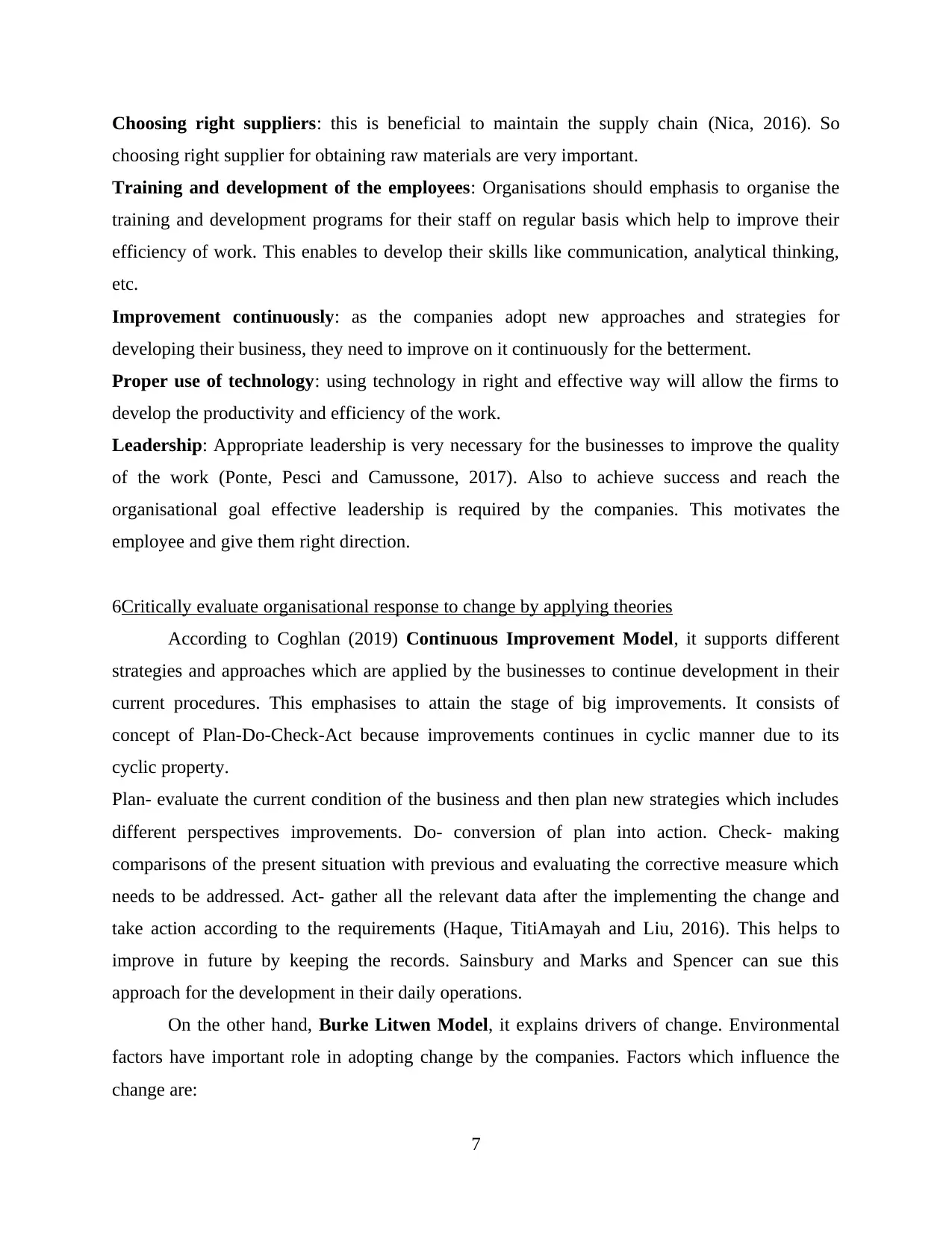
Choosing right suppliers: this is beneficial to maintain the supply chain (Nica, 2016). So
choosing right supplier for obtaining raw materials are very important.
Training and development of the employees: Organisations should emphasis to organise the
training and development programs for their staff on regular basis which help to improve their
efficiency of work. This enables to develop their skills like communication, analytical thinking,
etc.
Improvement continuously: as the companies adopt new approaches and strategies for
developing their business, they need to improve on it continuously for the betterment.
Proper use of technology: using technology in right and effective way will allow the firms to
develop the productivity and efficiency of the work.
Leadership: Appropriate leadership is very necessary for the businesses to improve the quality
of the work (Ponte, Pesci and Camussone, 2017). Also to achieve success and reach the
organisational goal effective leadership is required by the companies. This motivates the
employee and give them right direction.
6Critically evaluate organisational response to change by applying theories
According to Coghlan (2019) Continuous Improvement Model, it supports different
strategies and approaches which are applied by the businesses to continue development in their
current procedures. This emphasises to attain the stage of big improvements. It consists of
concept of Plan-Do-Check-Act because improvements continues in cyclic manner due to its
cyclic property.
Plan- evaluate the current condition of the business and then plan new strategies which includes
different perspectives improvements. Do- conversion of plan into action. Check- making
comparisons of the present situation with previous and evaluating the corrective measure which
needs to be addressed. Act- gather all the relevant data after the implementing the change and
take action according to the requirements (Haque, TitiAmayah and Liu, 2016). This helps to
improve in future by keeping the records. Sainsbury and Marks and Spencer can sue this
approach for the development in their daily operations.
On the other hand, Burke Litwen Model, it explains drivers of change. Environmental
factors have important role in adopting change by the companies. Factors which influence the
change are:
7
choosing right supplier for obtaining raw materials are very important.
Training and development of the employees: Organisations should emphasis to organise the
training and development programs for their staff on regular basis which help to improve their
efficiency of work. This enables to develop their skills like communication, analytical thinking,
etc.
Improvement continuously: as the companies adopt new approaches and strategies for
developing their business, they need to improve on it continuously for the betterment.
Proper use of technology: using technology in right and effective way will allow the firms to
develop the productivity and efficiency of the work.
Leadership: Appropriate leadership is very necessary for the businesses to improve the quality
of the work (Ponte, Pesci and Camussone, 2017). Also to achieve success and reach the
organisational goal effective leadership is required by the companies. This motivates the
employee and give them right direction.
6Critically evaluate organisational response to change by applying theories
According to Coghlan (2019) Continuous Improvement Model, it supports different
strategies and approaches which are applied by the businesses to continue development in their
current procedures. This emphasises to attain the stage of big improvements. It consists of
concept of Plan-Do-Check-Act because improvements continues in cyclic manner due to its
cyclic property.
Plan- evaluate the current condition of the business and then plan new strategies which includes
different perspectives improvements. Do- conversion of plan into action. Check- making
comparisons of the present situation with previous and evaluating the corrective measure which
needs to be addressed. Act- gather all the relevant data after the implementing the change and
take action according to the requirements (Haque, TitiAmayah and Liu, 2016). This helps to
improve in future by keeping the records. Sainsbury and Marks and Spencer can sue this
approach for the development in their daily operations.
On the other hand, Burke Litwen Model, it explains drivers of change. Environmental
factors have important role in adopting change by the companies. Factors which influence the
change are:
7
Paraphrase This Document
Need a fresh take? Get an instant paraphrase of this document with our AI Paraphraser
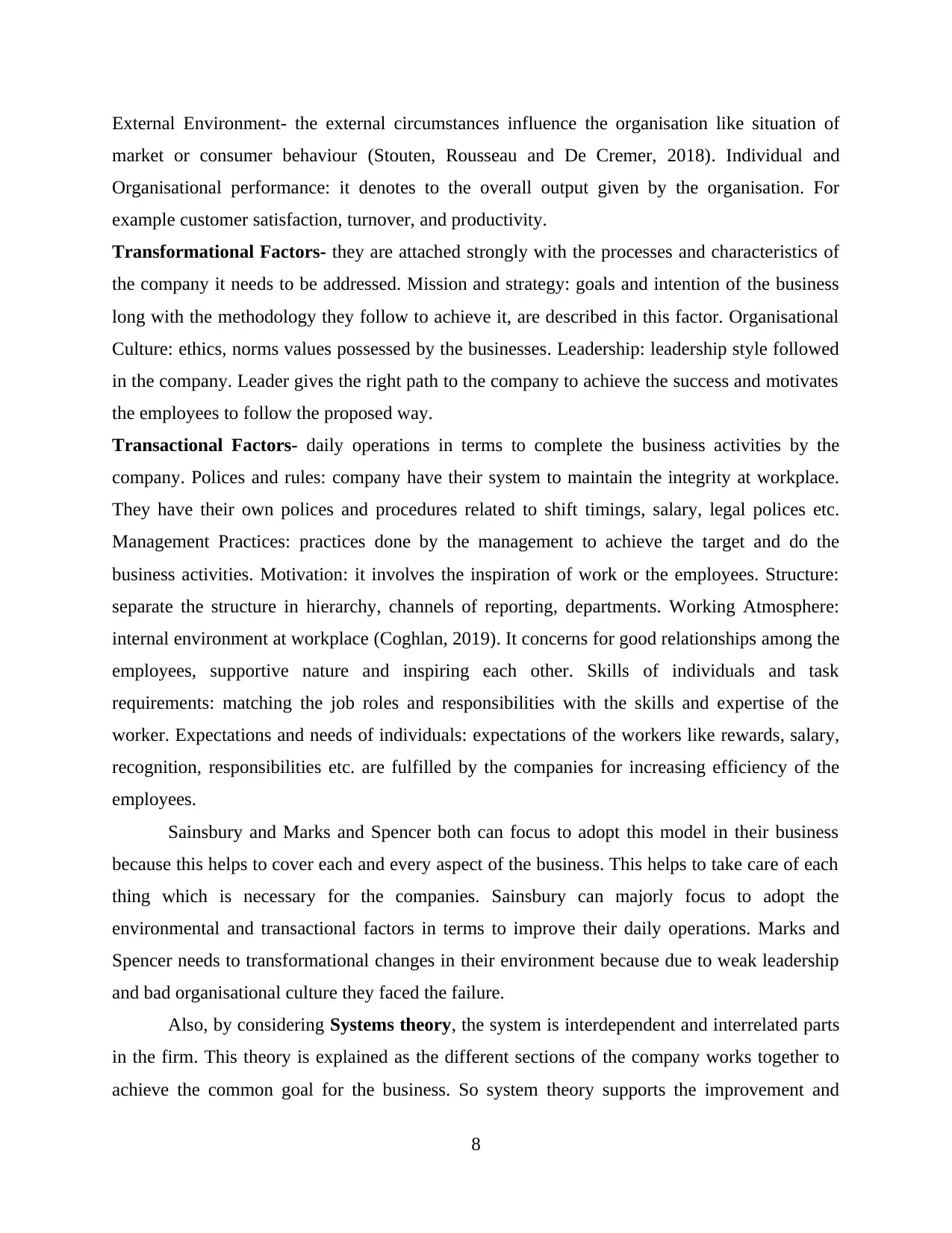
External Environment- the external circumstances influence the organisation like situation of
market or consumer behaviour (Stouten, Rousseau and De Cremer, 2018). Individual and
Organisational performance: it denotes to the overall output given by the organisation. For
example customer satisfaction, turnover, and productivity.
Transformational Factors- they are attached strongly with the processes and characteristics of
the company it needs to be addressed. Mission and strategy: goals and intention of the business
long with the methodology they follow to achieve it, are described in this factor. Organisational
Culture: ethics, norms values possessed by the businesses. Leadership: leadership style followed
in the company. Leader gives the right path to the company to achieve the success and motivates
the employees to follow the proposed way.
Transactional Factors- daily operations in terms to complete the business activities by the
company. Polices and rules: company have their system to maintain the integrity at workplace.
They have their own polices and procedures related to shift timings, salary, legal polices etc.
Management Practices: practices done by the management to achieve the target and do the
business activities. Motivation: it involves the inspiration of work or the employees. Structure:
separate the structure in hierarchy, channels of reporting, departments. Working Atmosphere:
internal environment at workplace (Coghlan, 2019). It concerns for good relationships among the
employees, supportive nature and inspiring each other. Skills of individuals and task
requirements: matching the job roles and responsibilities with the skills and expertise of the
worker. Expectations and needs of individuals: expectations of the workers like rewards, salary,
recognition, responsibilities etc. are fulfilled by the companies for increasing efficiency of the
employees.
Sainsbury and Marks and Spencer both can focus to adopt this model in their business
because this helps to cover each and every aspect of the business. This helps to take care of each
thing which is necessary for the companies. Sainsbury can majorly focus to adopt the
environmental and transactional factors in terms to improve their daily operations. Marks and
Spencer needs to transformational changes in their environment because due to weak leadership
and bad organisational culture they faced the failure.
Also, by considering Systems theory, the system is interdependent and interrelated parts
in the firm. This theory is explained as the different sections of the company works together to
achieve the common goal for the business. So system theory supports the improvement and
8
market or consumer behaviour (Stouten, Rousseau and De Cremer, 2018). Individual and
Organisational performance: it denotes to the overall output given by the organisation. For
example customer satisfaction, turnover, and productivity.
Transformational Factors- they are attached strongly with the processes and characteristics of
the company it needs to be addressed. Mission and strategy: goals and intention of the business
long with the methodology they follow to achieve it, are described in this factor. Organisational
Culture: ethics, norms values possessed by the businesses. Leadership: leadership style followed
in the company. Leader gives the right path to the company to achieve the success and motivates
the employees to follow the proposed way.
Transactional Factors- daily operations in terms to complete the business activities by the
company. Polices and rules: company have their system to maintain the integrity at workplace.
They have their own polices and procedures related to shift timings, salary, legal polices etc.
Management Practices: practices done by the management to achieve the target and do the
business activities. Motivation: it involves the inspiration of work or the employees. Structure:
separate the structure in hierarchy, channels of reporting, departments. Working Atmosphere:
internal environment at workplace (Coghlan, 2019). It concerns for good relationships among the
employees, supportive nature and inspiring each other. Skills of individuals and task
requirements: matching the job roles and responsibilities with the skills and expertise of the
worker. Expectations and needs of individuals: expectations of the workers like rewards, salary,
recognition, responsibilities etc. are fulfilled by the companies for increasing efficiency of the
employees.
Sainsbury and Marks and Spencer both can focus to adopt this model in their business
because this helps to cover each and every aspect of the business. This helps to take care of each
thing which is necessary for the companies. Sainsbury can majorly focus to adopt the
environmental and transactional factors in terms to improve their daily operations. Marks and
Spencer needs to transformational changes in their environment because due to weak leadership
and bad organisational culture they faced the failure.
Also, by considering Systems theory, the system is interdependent and interrelated parts
in the firm. This theory is explained as the different sections of the company works together to
achieve the common goal for the business. So system theory supports the improvement and
8
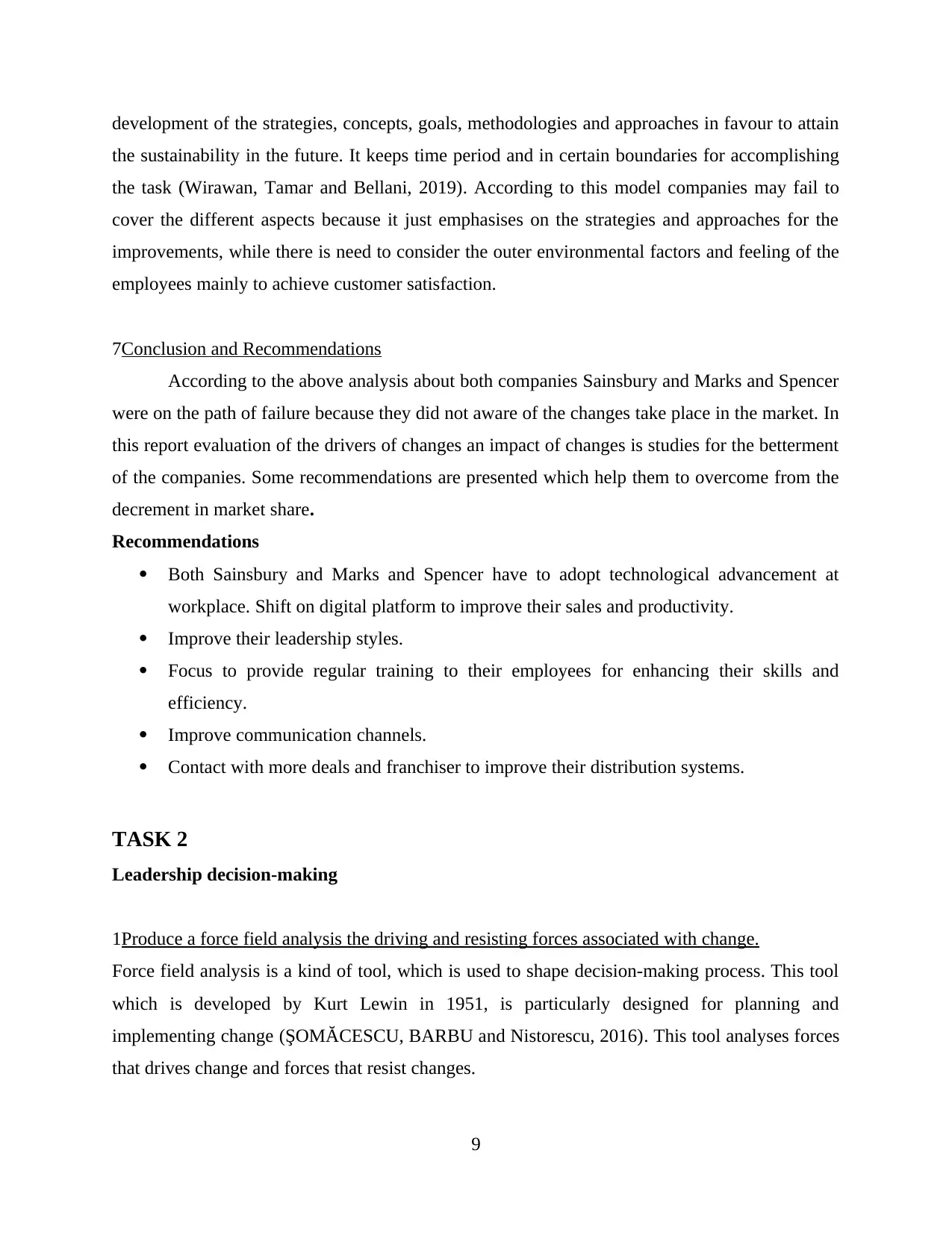
development of the strategies, concepts, goals, methodologies and approaches in favour to attain
the sustainability in the future. It keeps time period and in certain boundaries for accomplishing
the task (Wirawan, Tamar and Bellani, 2019). According to this model companies may fail to
cover the different aspects because it just emphasises on the strategies and approaches for the
improvements, while there is need to consider the outer environmental factors and feeling of the
employees mainly to achieve customer satisfaction.
7Conclusion and Recommendations
According to the above analysis about both companies Sainsbury and Marks and Spencer
were on the path of failure because they did not aware of the changes take place in the market. In
this report evaluation of the drivers of changes an impact of changes is studies for the betterment
of the companies. Some recommendations are presented which help them to overcome from the
decrement in market share.
Recommendations
Both Sainsbury and Marks and Spencer have to adopt technological advancement at
workplace. Shift on digital platform to improve their sales and productivity.
Improve their leadership styles.
Focus to provide regular training to their employees for enhancing their skills and
efficiency.
Improve communication channels.
Contact with more deals and franchiser to improve their distribution systems.
TASK 2
Leadership decision-making
1Produce a force field analysis the driving and resisting forces associated with change.
Force field analysis is a kind of tool, which is used to shape decision-making process. This tool
which is developed by Kurt Lewin in 1951, is particularly designed for planning and
implementing change (ŞOMĂCESCU, BARBU and Nistorescu, 2016). This tool analyses forces
that drives change and forces that resist changes.
9
the sustainability in the future. It keeps time period and in certain boundaries for accomplishing
the task (Wirawan, Tamar and Bellani, 2019). According to this model companies may fail to
cover the different aspects because it just emphasises on the strategies and approaches for the
improvements, while there is need to consider the outer environmental factors and feeling of the
employees mainly to achieve customer satisfaction.
7Conclusion and Recommendations
According to the above analysis about both companies Sainsbury and Marks and Spencer
were on the path of failure because they did not aware of the changes take place in the market. In
this report evaluation of the drivers of changes an impact of changes is studies for the betterment
of the companies. Some recommendations are presented which help them to overcome from the
decrement in market share.
Recommendations
Both Sainsbury and Marks and Spencer have to adopt technological advancement at
workplace. Shift on digital platform to improve their sales and productivity.
Improve their leadership styles.
Focus to provide regular training to their employees for enhancing their skills and
efficiency.
Improve communication channels.
Contact with more deals and franchiser to improve their distribution systems.
TASK 2
Leadership decision-making
1Produce a force field analysis the driving and resisting forces associated with change.
Force field analysis is a kind of tool, which is used to shape decision-making process. This tool
which is developed by Kurt Lewin in 1951, is particularly designed for planning and
implementing change (ŞOMĂCESCU, BARBU and Nistorescu, 2016). This tool analyses forces
that drives change and forces that resist changes.
9
⊘ This is a preview!⊘
Do you want full access?
Subscribe today to unlock all pages.

Trusted by 1+ million students worldwide
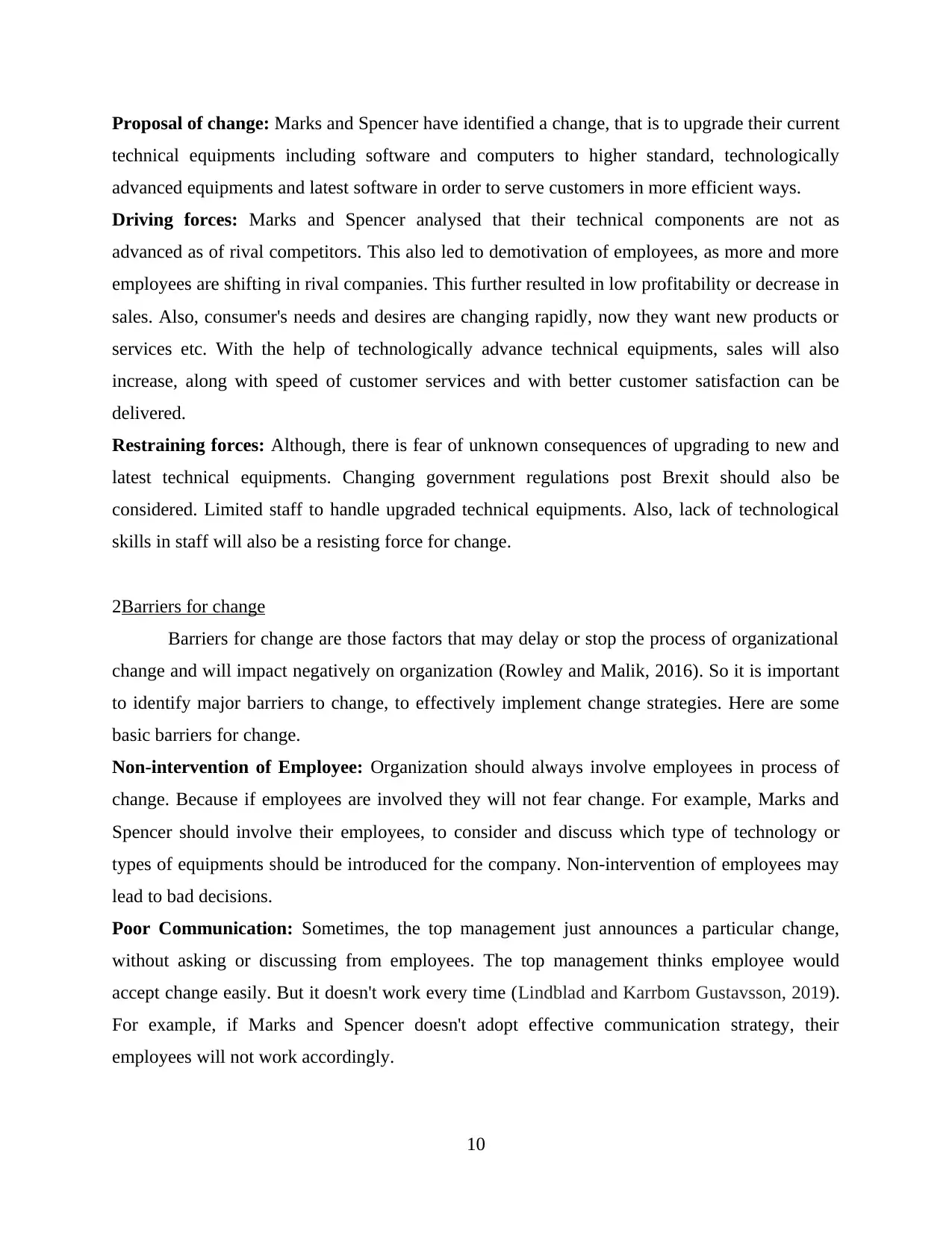
Proposal of change: Marks and Spencer have identified a change, that is to upgrade their current
technical equipments including software and computers to higher standard, technologically
advanced equipments and latest software in order to serve customers in more efficient ways.
Driving forces: Marks and Spencer analysed that their technical components are not as
advanced as of rival competitors. This also led to demotivation of employees, as more and more
employees are shifting in rival companies. This further resulted in low profitability or decrease in
sales. Also, consumer's needs and desires are changing rapidly, now they want new products or
services etc. With the help of technologically advance technical equipments, sales will also
increase, along with speed of customer services and with better customer satisfaction can be
delivered.
Restraining forces: Although, there is fear of unknown consequences of upgrading to new and
latest technical equipments. Changing government regulations post Brexit should also be
considered. Limited staff to handle upgraded technical equipments. Also, lack of technological
skills in staff will also be a resisting force for change.
2Barriers for change
Barriers for change are those factors that may delay or stop the process of organizational
change and will impact negatively on organization (Rowley and Malik, 2016). So it is important
to identify major barriers to change, to effectively implement change strategies. Here are some
basic barriers for change.
Non-intervention of Employee: Organization should always involve employees in process of
change. Because if employees are involved they will not fear change. For example, Marks and
Spencer should involve their employees, to consider and discuss which type of technology or
types of equipments should be introduced for the company. Non-intervention of employees may
lead to bad decisions.
Poor Communication: Sometimes, the top management just announces a particular change,
without asking or discussing from employees. The top management thinks employee would
accept change easily. But it doesn't work every time (Lindblad and Karrbom Gustavsson, 2019).
For example, if Marks and Spencer doesn't adopt effective communication strategy, their
employees will not work accordingly.
10
technical equipments including software and computers to higher standard, technologically
advanced equipments and latest software in order to serve customers in more efficient ways.
Driving forces: Marks and Spencer analysed that their technical components are not as
advanced as of rival competitors. This also led to demotivation of employees, as more and more
employees are shifting in rival companies. This further resulted in low profitability or decrease in
sales. Also, consumer's needs and desires are changing rapidly, now they want new products or
services etc. With the help of technologically advance technical equipments, sales will also
increase, along with speed of customer services and with better customer satisfaction can be
delivered.
Restraining forces: Although, there is fear of unknown consequences of upgrading to new and
latest technical equipments. Changing government regulations post Brexit should also be
considered. Limited staff to handle upgraded technical equipments. Also, lack of technological
skills in staff will also be a resisting force for change.
2Barriers for change
Barriers for change are those factors that may delay or stop the process of organizational
change and will impact negatively on organization (Rowley and Malik, 2016). So it is important
to identify major barriers to change, to effectively implement change strategies. Here are some
basic barriers for change.
Non-intervention of Employee: Organization should always involve employees in process of
change. Because if employees are involved they will not fear change. For example, Marks and
Spencer should involve their employees, to consider and discuss which type of technology or
types of equipments should be introduced for the company. Non-intervention of employees may
lead to bad decisions.
Poor Communication: Sometimes, the top management just announces a particular change,
without asking or discussing from employees. The top management thinks employee would
accept change easily. But it doesn't work every time (Lindblad and Karrbom Gustavsson, 2019).
For example, if Marks and Spencer doesn't adopt effective communication strategy, their
employees will not work accordingly.
10
Paraphrase This Document
Need a fresh take? Get an instant paraphrase of this document with our AI Paraphraser
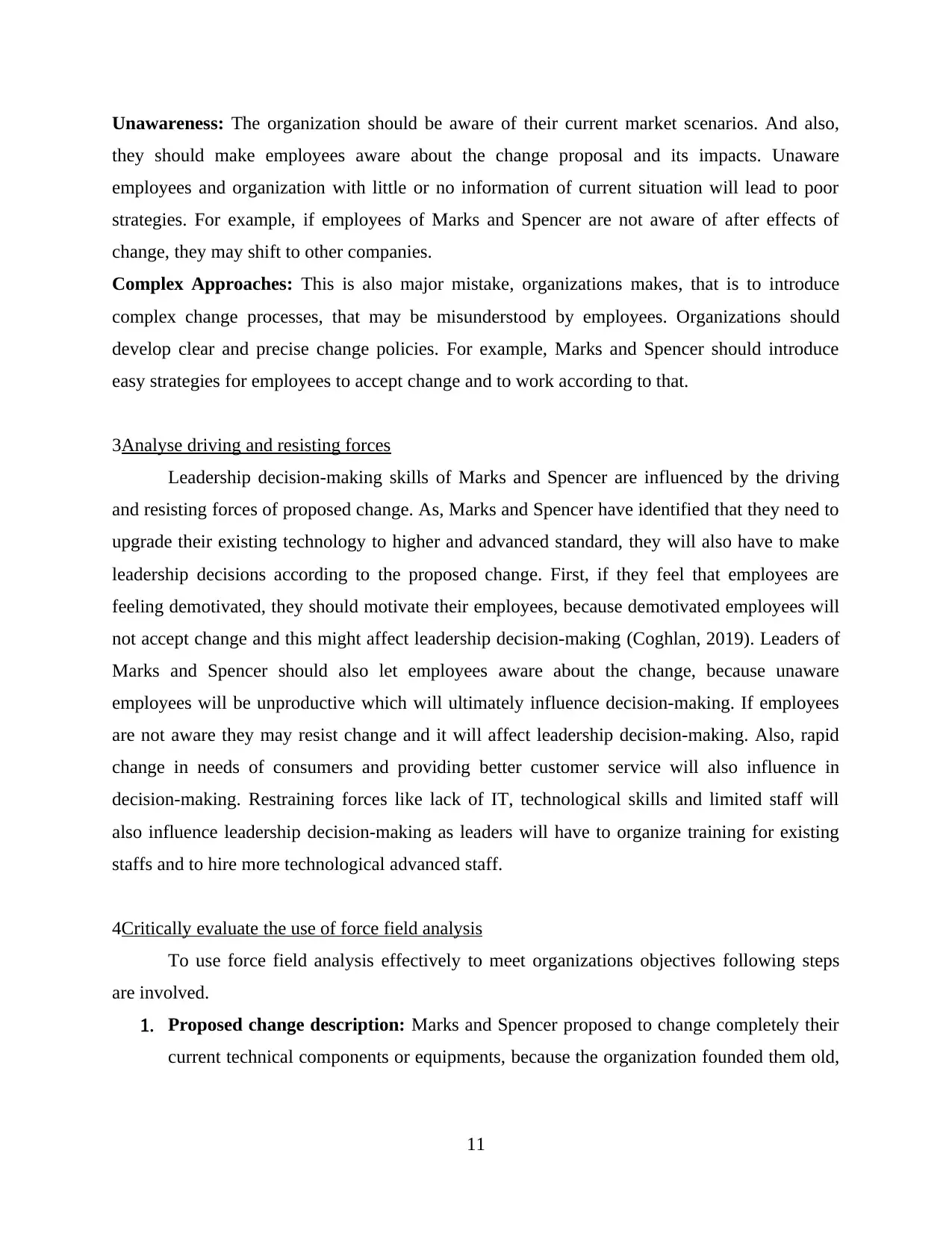
Unawareness: The organization should be aware of their current market scenarios. And also,
they should make employees aware about the change proposal and its impacts. Unaware
employees and organization with little or no information of current situation will lead to poor
strategies. For example, if employees of Marks and Spencer are not aware of after effects of
change, they may shift to other companies.
Complex Approaches: This is also major mistake, organizations makes, that is to introduce
complex change processes, that may be misunderstood by employees. Organizations should
develop clear and precise change policies. For example, Marks and Spencer should introduce
easy strategies for employees to accept change and to work according to that.
3Analyse driving and resisting forces
Leadership decision-making skills of Marks and Spencer are influenced by the driving
and resisting forces of proposed change. As, Marks and Spencer have identified that they need to
upgrade their existing technology to higher and advanced standard, they will also have to make
leadership decisions according to the proposed change. First, if they feel that employees are
feeling demotivated, they should motivate their employees, because demotivated employees will
not accept change and this might affect leadership decision-making (Coghlan, 2019). Leaders of
Marks and Spencer should also let employees aware about the change, because unaware
employees will be unproductive which will ultimately influence decision-making. If employees
are not aware they may resist change and it will affect leadership decision-making. Also, rapid
change in needs of consumers and providing better customer service will also influence in
decision-making. Restraining forces like lack of IT, technological skills and limited staff will
also influence leadership decision-making as leaders will have to organize training for existing
staffs and to hire more technological advanced staff.
4Critically evaluate the use of force field analysis
To use force field analysis effectively to meet organizations objectives following steps
are involved.
1. Proposed change description: Marks and Spencer proposed to change completely their
current technical components or equipments, because the organization founded them old,
11
they should make employees aware about the change proposal and its impacts. Unaware
employees and organization with little or no information of current situation will lead to poor
strategies. For example, if employees of Marks and Spencer are not aware of after effects of
change, they may shift to other companies.
Complex Approaches: This is also major mistake, organizations makes, that is to introduce
complex change processes, that may be misunderstood by employees. Organizations should
develop clear and precise change policies. For example, Marks and Spencer should introduce
easy strategies for employees to accept change and to work according to that.
3Analyse driving and resisting forces
Leadership decision-making skills of Marks and Spencer are influenced by the driving
and resisting forces of proposed change. As, Marks and Spencer have identified that they need to
upgrade their existing technology to higher and advanced standard, they will also have to make
leadership decisions according to the proposed change. First, if they feel that employees are
feeling demotivated, they should motivate their employees, because demotivated employees will
not accept change and this might affect leadership decision-making (Coghlan, 2019). Leaders of
Marks and Spencer should also let employees aware about the change, because unaware
employees will be unproductive which will ultimately influence decision-making. If employees
are not aware they may resist change and it will affect leadership decision-making. Also, rapid
change in needs of consumers and providing better customer service will also influence in
decision-making. Restraining forces like lack of IT, technological skills and limited staff will
also influence leadership decision-making as leaders will have to organize training for existing
staffs and to hire more technological advanced staff.
4Critically evaluate the use of force field analysis
To use force field analysis effectively to meet organizations objectives following steps
are involved.
1. Proposed change description: Marks and Spencer proposed to change completely their
current technical components or equipments, because the organization founded them old,
11
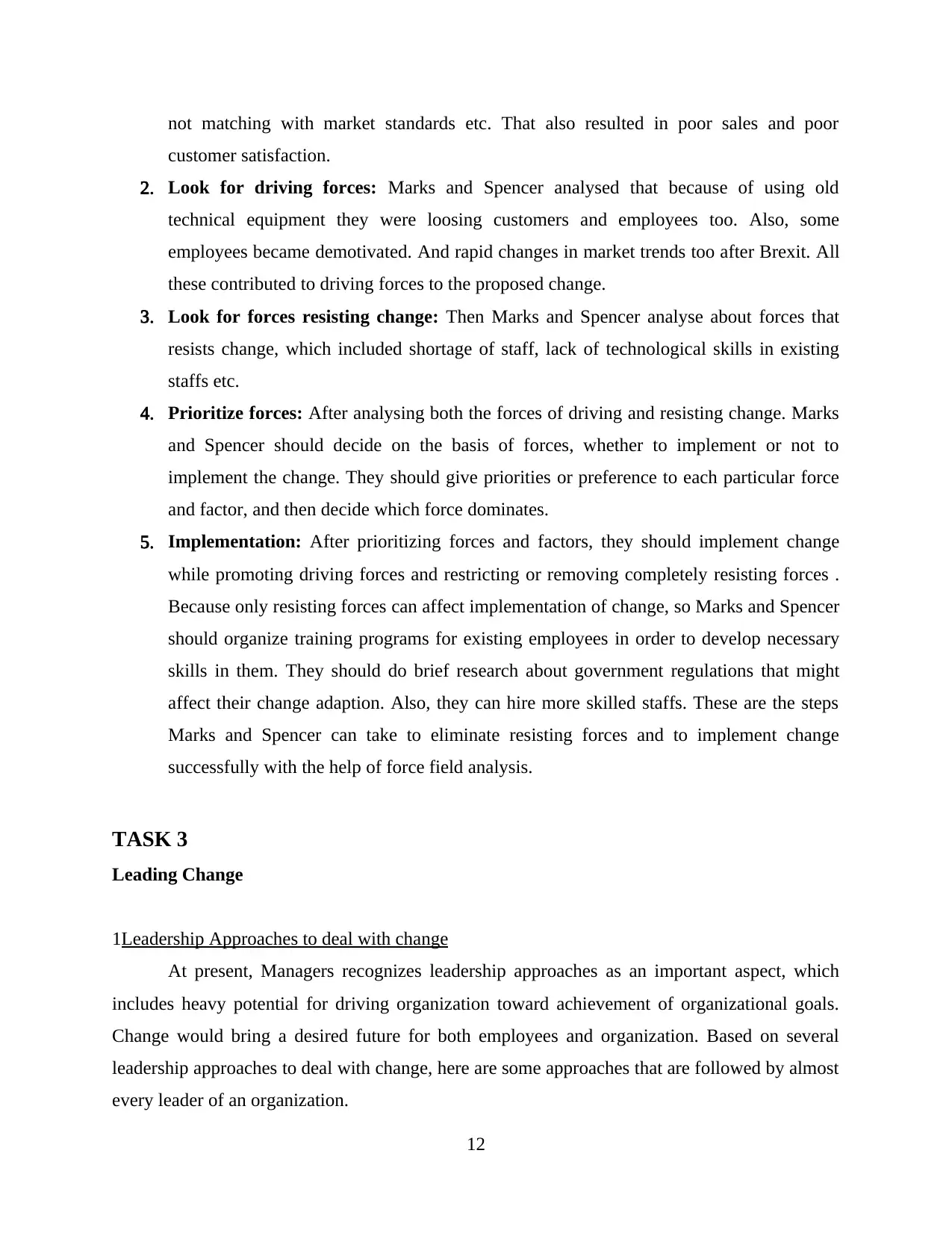
not matching with market standards etc. That also resulted in poor sales and poor
customer satisfaction.
2. Look for driving forces: Marks and Spencer analysed that because of using old
technical equipment they were loosing customers and employees too. Also, some
employees became demotivated. And rapid changes in market trends too after Brexit. All
these contributed to driving forces to the proposed change.
3. Look for forces resisting change: Then Marks and Spencer analyse about forces that
resists change, which included shortage of staff, lack of technological skills in existing
staffs etc.
4. Prioritize forces: After analysing both the forces of driving and resisting change. Marks
and Spencer should decide on the basis of forces, whether to implement or not to
implement the change. They should give priorities or preference to each particular force
and factor, and then decide which force dominates.
5. Implementation: After prioritizing forces and factors, they should implement change
while promoting driving forces and restricting or removing completely resisting forces .
Because only resisting forces can affect implementation of change, so Marks and Spencer
should organize training programs for existing employees in order to develop necessary
skills in them. They should do brief research about government regulations that might
affect their change adaption. Also, they can hire more skilled staffs. These are the steps
Marks and Spencer can take to eliminate resisting forces and to implement change
successfully with the help of force field analysis.
TASK 3
Leading Change
1Leadership Approaches to deal with change
At present, Managers recognizes leadership approaches as an important aspect, which
includes heavy potential for driving organization toward achievement of organizational goals.
Change would bring a desired future for both employees and organization. Based on several
leadership approaches to deal with change, here are some approaches that are followed by almost
every leader of an organization.
12
customer satisfaction.
2. Look for driving forces: Marks and Spencer analysed that because of using old
technical equipment they were loosing customers and employees too. Also, some
employees became demotivated. And rapid changes in market trends too after Brexit. All
these contributed to driving forces to the proposed change.
3. Look for forces resisting change: Then Marks and Spencer analyse about forces that
resists change, which included shortage of staff, lack of technological skills in existing
staffs etc.
4. Prioritize forces: After analysing both the forces of driving and resisting change. Marks
and Spencer should decide on the basis of forces, whether to implement or not to
implement the change. They should give priorities or preference to each particular force
and factor, and then decide which force dominates.
5. Implementation: After prioritizing forces and factors, they should implement change
while promoting driving forces and restricting or removing completely resisting forces .
Because only resisting forces can affect implementation of change, so Marks and Spencer
should organize training programs for existing employees in order to develop necessary
skills in them. They should do brief research about government regulations that might
affect their change adaption. Also, they can hire more skilled staffs. These are the steps
Marks and Spencer can take to eliminate resisting forces and to implement change
successfully with the help of force field analysis.
TASK 3
Leading Change
1Leadership Approaches to deal with change
At present, Managers recognizes leadership approaches as an important aspect, which
includes heavy potential for driving organization toward achievement of organizational goals.
Change would bring a desired future for both employees and organization. Based on several
leadership approaches to deal with change, here are some approaches that are followed by almost
every leader of an organization.
12
⊘ This is a preview!⊘
Do you want full access?
Subscribe today to unlock all pages.

Trusted by 1+ million students worldwide
1 out of 17
Related Documents
Your All-in-One AI-Powered Toolkit for Academic Success.
+13062052269
info@desklib.com
Available 24*7 on WhatsApp / Email
![[object Object]](/_next/static/media/star-bottom.7253800d.svg)
Unlock your academic potential
Copyright © 2020–2025 A2Z Services. All Rights Reserved. Developed and managed by ZUCOL.




